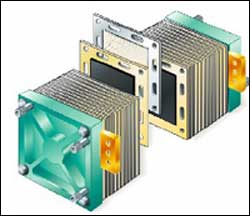Robotic assembly of fuel cells could hasten hydrogen economy

Caption: Simplified schematic representation of a fuel cell stack. Credit: Image courtesy of PEMEAS.
Echoes of a “hydrogen economy” are reverberating across the country, but a number of roadblocks stand in the way. One of the biggest, experts say, is the high cost of manufacturing fuel cells. A new research project at Rensselaer Polytechnic Institute aims to tackle the challenge of mass production by using robots to assemble fuel cell stacks.
The project, which will combine the resources of Rensselaer’s Flexible Manufacturing Center (FMC) and Center for Automation Technologies and Systems (CATS), was recently supported with a major research equipment award from the Robotics Industries Association (RIA). As one of four universities selected in a nationwide competition, Rensselaer will receive three new industrial robot systems to help develop a flexible robotic process to produce fuel cell stacks.
“The U.S. Department of Energy has suggested that the cost of manufacturing fuel cells is the single biggest obstacle on the road to the hydrogen economy,” says Raymond Puffer, co-director of the FMC. “We are addressing a component that represents a major portion of the total systems cost: the stack assembly in a proton exchange membrane (PEM) fuel cell.”
In a PEM fuel cell, hydrogen is split into protons and electrons on one side of a thin polymer membrane. The membrane allows protons to pass through, but electrons are forced to go around, creating a flow of electrical current. On the other side of the membrane, the electrons recombine with the protons and with oxygen from the air, creating water and heat as the only byproducts. To produce enough energy for most applications, multiple fuel cells are combined in a fuel cell stack.
“It is currently common to take as long as a full day to assemble and leak-test a single stack,” says Stephen Derby, FMC’s other co-director. “To be commercially viable, stack assembly must be accomplished in minutes, not hours.”
Derby, Puffer, and their colleagues already have applied their expertise in automating manufacturing processes through a collaboration with PEMEAS, a supplier of high-temperature membrane electrode assemblies (MEAs) for PEM fuel cells. In 2002 the researchers developed a fully automated $5 million MEA pilot manufacturing line at the company’s plant in Frankfurt, Germany, where these MEAs were formerly put together by hand.
To begin addressing the PEM stack assembly process, the researchers plan to create a flexible robotic “workcell,” which will include various pieces of robotic equipment designed to handle materials with great precision. The RIA award includes three full industrial robot systems, donated by the Kuka Robot Group, and collision-avoidance sensors for the systems, provided by RAD, a robotics accessories supplier.
“Many of the materials in PEM stacks are thin, flexible, soaked in corrosive acids, or highly sensitive to changes in humidity and temperature,” Puffer says. “This makes material handling orders of magnitude more difficult than methods used for simple flexible materials such as paper.” The researchers will use existing automated methods to gain a deeper understanding of how PEM stack materials respond to various handling techniques, while also researching new ways to sense material properties throughout the process.
The project will play an important role in Rensselaer’s new interdisciplinary program to train doctoral students in fuel cell science and engineering. The program is supported by a $3.2 million, first-of-its-kind fuel cell research education grant from the National Science Foundation combined with a $1.6 million investment by Rensselaer.
Additional research support will be sought from federal agencies as well as an industry consortium, with the goal of increasing the understanding of the PEM stack assembly process across the entire robotics industry. The researchers will give a final report in two years at the next International Robots & Vision Conference in 2007.
Media Contact
All latest news from the category: Power and Electrical Engineering
This topic covers issues related to energy generation, conversion, transportation and consumption and how the industry is addressing the challenge of energy efficiency in general.
innovations-report provides in-depth and informative reports and articles on subjects ranging from wind energy, fuel cell technology, solar energy, geothermal energy, petroleum, gas, nuclear engineering, alternative energy and energy efficiency to fusion, hydrogen and superconductor technologies.
Newest articles

Parallel Paths: Understanding Malaria Resistance in Chimpanzees and Humans
The closest relatives of humans adapt genetically to habitats and infections Survival of the Fittest: Genetic Adaptations Uncovered in Chimpanzees Görlitz, 10.01.2025. Chimpanzees have genetic adaptations that help them survive…

You are What You Eat—Stanford Study Links Fiber to Anti-Cancer Gene Modulation
The Fiber Gap: A Growing Concern in American Diets Fiber is well known to be an important part of a healthy diet, yet less than 10% of Americans eat the minimum recommended…

Trust Your Gut—RNA-Protein Discovery for Better Immunity
HIRI researchers uncover control mechanisms of polysaccharide utilization in Bacteroides thetaiotaomicron. Researchers at the Helmholtz Institute for RNA-based Infection Research (HIRI) and the Julius-Maximilians-Universität (JMU) in Würzburg have identified a…



